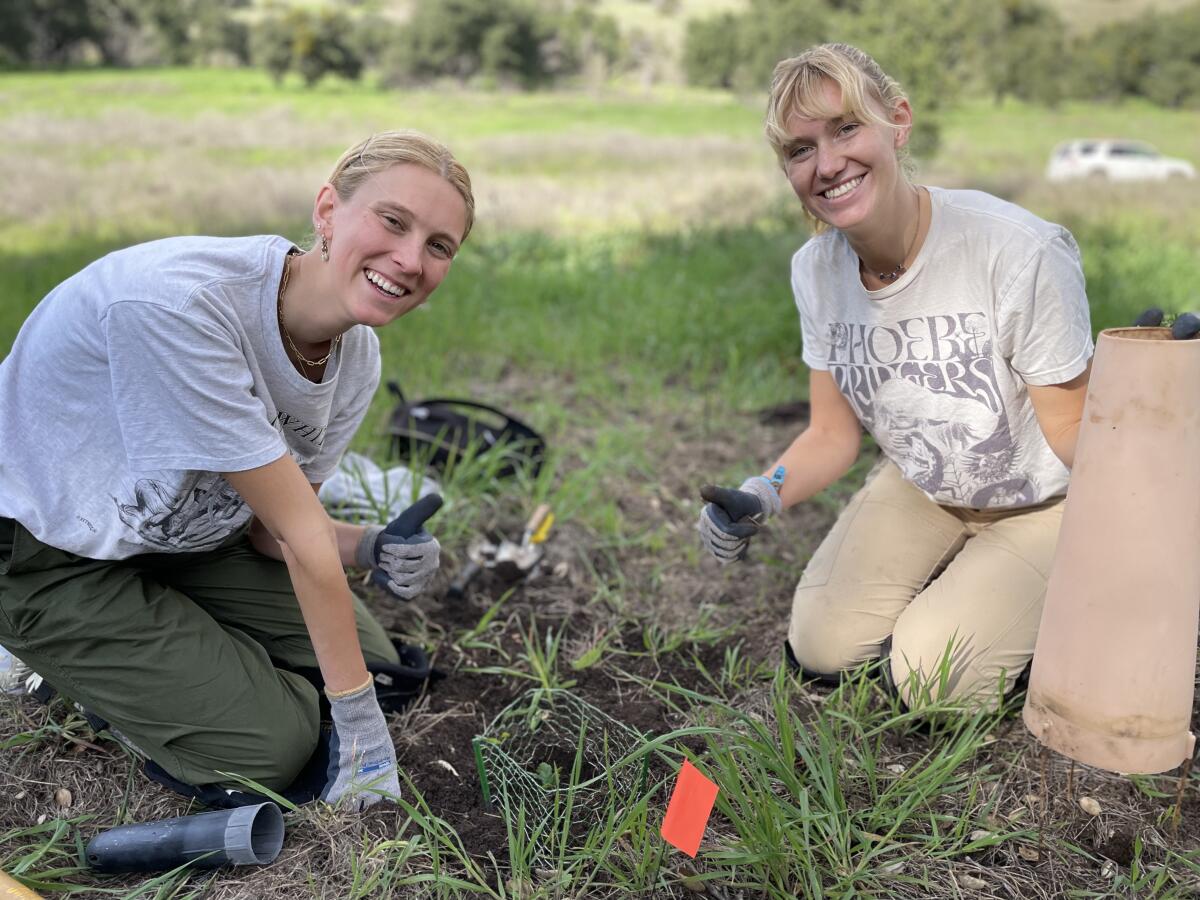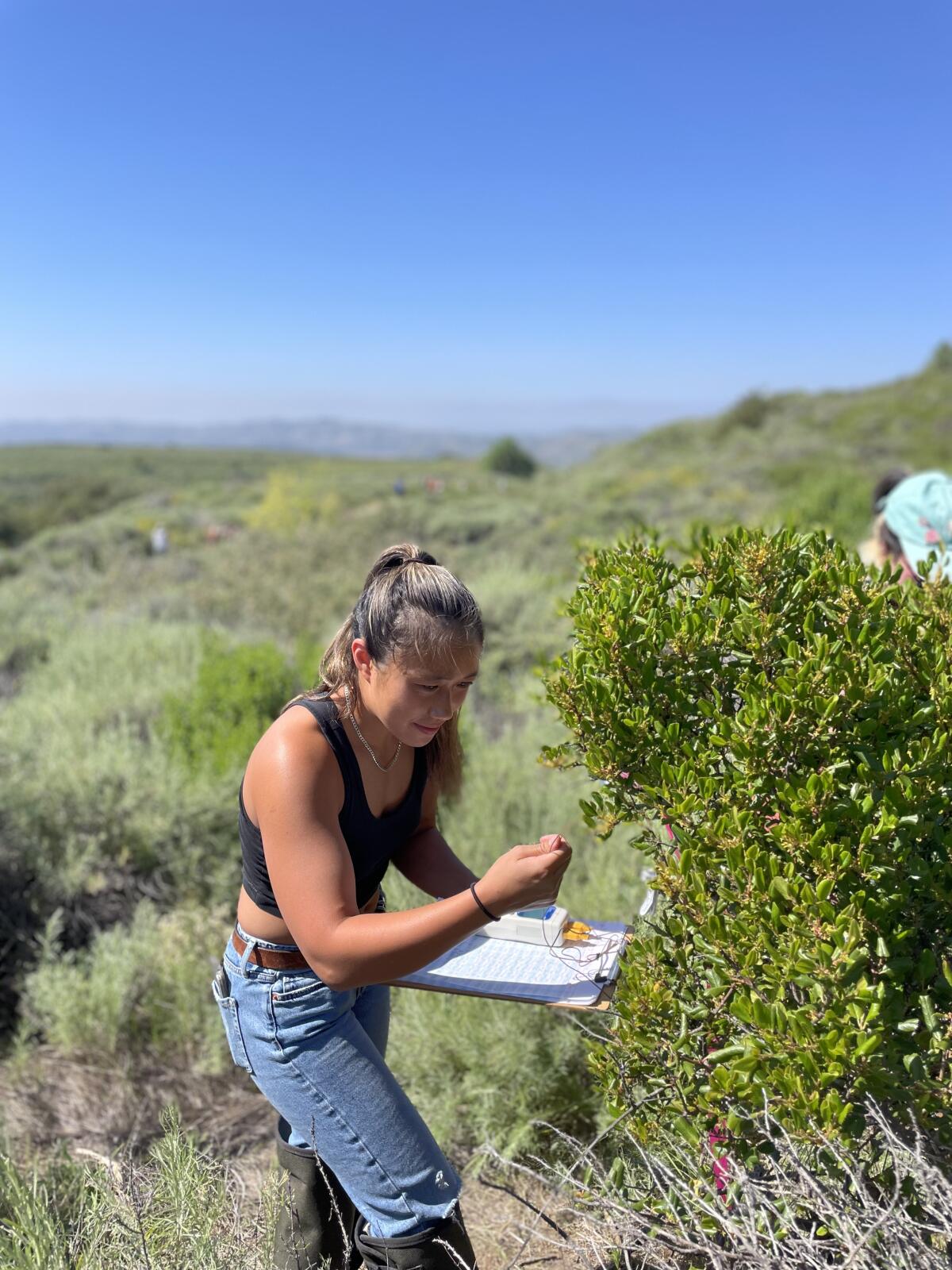Chapman students partner with Irvine Ranch Conservancy to collect climate change research

- Share via
As temperatures rise throughout Southern California this summer, residents might be monitoring their lawns, houseplants and backyards. Students from Chapman University’s Schmid College of Science and Technology have also been monitoring the vegetation in Orange County’s greater backyard. The local students partnered with the Irvine Ranch Conservancy for a research project aimed at determining the highest temperatures that can be withstood by the region’s native plant species.
“It was an incredible opportunity for our students to be able to explore their own backyard, to be able to contribute to our understanding of the planet and to be able to recognize themselves as scientists,” said Gregory Goldsmith, associate professor of biological sciences at Chapman University.
The nonprofit Irvine Ranch Conservancy aims to steward the “protection, restoration and enhancement of urban wildlands” in Southern California, including the 40,000 acres of open land at Irvine Ranch in Orange County. Goldsmith set up the collaboration between Chapman University and the conservancy by reaching out to the latter’s monitoring and research team program manager, Eliza Hernandez.
“My interest as a professor is always in creating experiences for students that are as real as possible relative to what I expect them to see when they graduate and leave campus,” said Goldsmith.
Goldsmith was looking for a way for students to not only participate in a real research project but also give back to the community.
“At IRC, we are always thinking about how we can engage students to foster environmental stewardship, so working with Professor Goldsmith and his class on this research project was a great opportunity to inspire future generations,” said Hernandez. “Additionally, the student-led research furthers our understanding of climate change effects on coastal sage scrub and can inform IRC’s management of this threatened plant community into the future.”
Students visited different sites within Irvine Ranch Natural Landmarks, such as Hicks Haul Road and Saddleback Wilderness, to practice their identification of native plant species and contributed to a restoration project while ultimately collecting their own research data. Students collected data on 12 different plant species by measuring the thermal tolerance of leaves from each species. Leaf thermal tolerance indicates the temperature at which the photosynthetic machinery in the leaf begins to break down. The photosynthesis process is critical for life on Earth, since it produces oxygen.
“We are really interested in how extreme temperatures will affect plant function and ultimately the survival of the plants species we have in the region,” said Goldsmith. “Understanding different thermal tolerances will help us make better conservation, management and restoration decisions.”

Recent Chapman gradate Gabriella Dauber, who received her bachelor’s degree in biological sciences, was among the students who participated in the project, collecting data from 12 different plant species, like coastal goldenbush, black sage, sagebrush, toyon and coyote brush.
“My group in particular looked at different structural traits of leaves, such as thickness, width and length,” said Dauber.
Goldsmith said the group found the average leaf thermal tolerance was 48.8 degrees Celsius, but they ranged among species from 46.1 to 54.1 degrees, or about 115 to 129 degrees Fahrenheit.
“One of the things students did was pull down NASA satellite records of land surface temperatures, and when they do that they see that these sites already at times experience temperatures greater than 50 degrees Celsius,” said Goldsmith.
This significant research can be vital to conservation efforts to restore resilient plant communities for the future. In fact, the findings will be presented at next month’s Ecological Society of America’s annual conference in Long Beach by the Schmid College students, with IRC as co-authors. The opportunity will give students the chance to practice the second part of research project like this.
“Not only is it important to be able to collect the data but also be able to interpret and then communicate that to an audience,” said Dauber.
The Ecological Society of America is the world’s largest professional society for ecologists and this year’s meeting is expected to draw nearly 3,500 participants. Goldsmith said the group is also in the process of putting together all the data in a research paper they plan to submit to a scientific journal for publication.
Dauber said the overall experience has been valuable, and she is grateful she had the opportunity.
“It really did feel like I was part of a research project from start to finish, even though it was a lab class at Chapman,” said Dauber. “I really did learn a lot of different important skills.”
Goldsmith hopes the university’s partnership will continue in the future.
“I feel really fortunate to be able to partner with Irvine Ranch Conservancy, and our goal is to continue to collaborate in a way that continues to create value for our students and for the management of the conservancy and the land they steward.”
All the latest on Orange County from Orange County.
Get our free TimesOC newsletter.
You may occasionally receive promotional content from the Daily Pilot.




